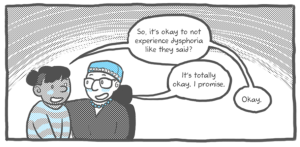
Person working from home on a laptop.
I’ll never forget how I felt when the head of my department at work made a comment about an autistic performer. Talking about this person’s social awkwardness and signing talent, she said something along the lines of, “But she’s autistic, right? That’s why she’s like that.”
I remember thinking, “Is that how she sees me? Do I even belong in this job?” Unlike many autistic people, I generally have no issue with eye contact—but for the rest of the meeting, I stared at my notes and avoided everyone’s gaze, rushing to get out of the room as soon as it was over.
No one on my team knew that I was autistic unless any of them had bothered to dig up my reporting on the subject. And now, I felt I’d better keep it that way.
Between ableist microaggressions, inaccessibility, and harmful myths about autistic people, it’s not surprising that only 14% of autistic adults held paid jobs in their communities, according to 2017 research from Drexel University’s Autism Institute.
About 85% of autistic college graduates are unemployed, compared to the national unemployment rate for college graduates of 2.5 percent.
As hard as it was to remember at that moment, I knew that I wasn’t the problem. Fortunately, this job wasn’t my first introduction to working. I’d had supportive supervisors and inclusive workplaces before, and that what I needed was an environment that wanted me to succeed as I am.
Employers should want their workplaces to be inclusive and adaptive. Research shows that autistic employees are an asset, and beyond that, we’re also people and we should be treated with respect and empathy.
We’re individuals who bring different skills and expertise to a team, not a monolith or a prescribed set of stereotypes—and I know I’m personally happiest when I don’t feel like my being autistic is a hindrance to my job.
Here are a few ways that workplaces can help support autistic employees from the hiring process to the day-to-day environment:
1. Create individualized radical access for all employees
As autistic disability justice organizer Lydia X. Z. Brown says, “Radical access means taking into account my baseline and fluctuating needs and capacities, and adjusting accordingly—it’s more important that I get done what needs to get done than how I do it.”
It’s important to remember that autistic people are not identical; we don’t share the same experiences with autism or with workplaces and there isn’t a one-size-fits-all answer. As the saying that’s common among the autistic community goes: “If you’ve met one autistic person, you’ve met one autistic person.”
The easiest way to make sure your workplace is accessible is by being flexible with your employees, particularly to individual needs.
I always prefer to have time to plan for a conversation, for example; if my supervisor calls me unexpectedly and ask me whether our organization’s social media engagement is up this week, I might not know off the top of my head and I’ll feel unprepared.
If she asks me to talk to her at 2 p.m. about social media engagement instead, I’ll have detailed notes ready and all the analytics and pages pulled up in case she has questions.
Not every autistic person prefers this, but it’s just a matter of communicating with your employees and asking them how they work best, and then talking about how that fits with the entire team, the overall company, and individual responsibilities.
“I benefit greatly from flexible hours—mornings tend to be hard for me, and while I can do them if I need to (such as an important meeting or a court date scheduled for a morning time), it’s hard to do them consistently and reliably,” explains Brown.
That’s just one way that employers can be flexible for autistic employees: By listening to what our needs are and finding ways to adjust accordingly.
2. Don’t place the burden on autistic employees
The challenge with accessibility is that it often falls to employees to point out a problem or ask for an accommodation. This can be tricky to fix since you don’t want to make assumptions about what access means for everyone or what your individual employees’ needs are.
How comfortable do your employees feel going to you with individual access needs? Have you specifically mentioned in the workplace that employees should talk to you about things like their preferred communication style, their work schedule, or their workspace or work equipment?
Do you use phrases that suggest you’re open to discussion, like: “In the past, we’ve been asking that employees only work remotely once a week, but if you work better when you can work remotely more often than that, let’s talk about it”?
Jennifer Malia, an autistic writer and English professor at Norfolk State University, says, “Given how difficult it is for me to get work done in noisy environments (almost all sounds are distracting for me), I’m much more productive when working remotely.” Again, that isn’t true for every autistic employee, which is why it’s important to make options available.
Brown suggests that a workspace should offer inclusive spaces whenever possible: “Offices should ideally have a mixture of open space and private, enclosed space, allowing employees who need access to bigger and open spaces to have it while enabling employees who need privacy and a door that actually closes to have that.”
3. Look at your communication practices and other processes
Communication is important, but that doesn’t mean your employees naturally communicate the exact same way that you do.
In my work environments, I love to have collaborative meetings, one-on-one or in a group, where we can brainstorm and bounce ideas off each other. But when it comes to deadlines and assignments, I need a physical document.
At the very least, the basic sketches of what we’re thinking (due date and the scope of the project), and ideally more detailed guidelines or an example. I do my best work when my teammates ask me how I communicate best and what my style and preferences are, and then we talk about what our processes should be as a group to be efficient and accessible to everyone.
“I’ve had phone interviews where I had trouble with auditory processing, which many other autistic people share. I only hear and understand about 75 percent of what is said in most phone conversations, my least favorite method of communication,” says Malia.
During the hiring process and beyond, it’s important to be open to different forms of communication in your workplace (even if you’re not set in a 9-to-5 office or employees are working independently or remotely).
“If I’m going somewhere new, I often need support getting there, so for some people Skype interviews or auditions might be good,” Imogen Roberts, a London-based writer and performer, tells Everyday Feminism.
Ask your employees: What works for you? How can I better support you? What feels most effective? Does it work for you when I label my emails (for example, putting “Timely” in the subject line) or does it make you feel rushed? Would you rather I drop by and just talk to you in person when I need something, or is it better if I send an email first?
Emily, the author of the blog 21andsensory, suggests that employers and workplaces “provide mentors for weekly or bi-weekly catch-ups, as just having someone to chat to about work and what you need more help with can be very helpful.”
4. Let go of assumptions and stereotypes
There are a lot of harmful myths and stereotypes about autistic people that are perpetuated by media that’s largely created by and for non-autistic audiences, so it’s worth reiterating: If you know one autistic person, you know one autistic person.
Just because you saw an autistic character on television who loved counting doesn’t mean your autistic employee will also love counting. (Many of us are bad at math, contrary to popular belief—I am!)
“Employers shouldn’t assume that autistic candidates are only “good” for some types of work or careers because we are all different people,” explains Brown. “Plenty of us actually like and enjoy dynamic work, where every day is different, where we can be challenged and grow, where we are doing anything but repetitive and monotonous work.”
Many people assume that autistic people aren’t empathetic, creative, outgoing, extroverted, dynamic, flexible, fashionable, or adventurous—and those assumptions are false.
Like non-autistic people, we’re a diverse community and we come from a variety of backgrounds, with different interests, goals, and skill sets. I have a novelty, whimsical sense of style that involves lots of tulle, glitter, and colorful prints, while my autistic friend prefers plain clothing that’s inexpensive and utilitarian.
5. Find autistic people to fill leadership and management roles
If you really want to create lasting change, not only in your organization or industry but for autistic people to be respected and radically included everywhere, you need to hire autistic people to leadership and management roles.
The assumption that Lyn Miller-Lachmann, a writer and translator from New York City, runs into often is that “we’re not team players, that we can’t collaborate in groups, and can only accomplish solitary tasks.”
And that’s a problem, she says, because “as a result, we’re denied choice assignments where we can make a significant contribution and passed up for promotions where interpersonal interaction and leadership are important.”
Autistic people need the opportunity to progress in our careers according to our goals—to learn new tasks, take on responsibilities, manage people (if we’d like to), develop strategy, and be an integral part of the organization’s success.
In general, hiring needs to be a fairer process, particularly because autistic people might not have the expected professional background you’re looking for.
“Hire people with long periods of unemployment or underemployment. Hire people with criminal records. Hire people who do not have fixed addresses. Autistic people, especially those at the margins of the margins, may have survived institutionalization, incarceration, and homelessness, and deserve to be considered fairly,” says Brown.
This is true not of only entry- and mid-level positions but leadership roles as well. Allow potential employees to demonstrate their skills outside of what their professional experience on a resume might show.
***
I’m autistic, and this is how you can support me at work: Give me the ability to adapt my schedule and work flexible hours. Offer me the ability to get deeply involved in strategy, dynamic work, and tasks.
Let me take on projects and responsibilities outside the scope of my job so I can challenge myself and advance my career. Give me the chance to manage other people, because I’m compassionate but extremely organized and always know when deadlines are coming up.
Allow me to work remotely, but honor my extroverted nature and offer opportunities for collaboration and community because I work best when I’m part of a passionate team. Let me wear my odd, offbeat clothes to work because I need them to think creatively.
But that’s not how all autistic people work. We’re different. Just because you have a sense of how I tick and what motivates me doesn’t mean you understand every autistic employee.
If you want a workplace that’s radically accessible to everyone, you need to be flexible and adaptable, willing to listen to what works for an employee and find a way to make that fit with the structure of the team or organization.
Autistic employees are an asset if you give us the support and opportunity to do our best work.
[do_widget id=’text-101′]
Alaina Leary is an Everyday Feminism Reporting Fellow. She is a Bostonian currently studying for her MA in publishing at Emerson College. She’s a disabled, queer activist and is on the social media team at We Need Diverse Books. She can often be found re-reading her favorite books and covering everything in glitter. You can find her at her website or on Instagram and Twitter @alainaskeys. Read her articles here.
Search our 3000+ articles!
Read our articles about:
Our online racial justice training
Used by hundreds of universities, non-profits, and businesses.
Click to learn more




















